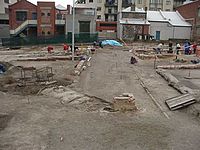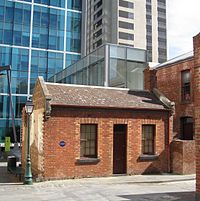
A brothel, bordello, ranch, or whorehouse is a place where people engage in sexual activity with prostitutes. However, for legal or cultural reasons, establishments often describe themselves as massage parlors, bars, strip clubs, body rub parlours, studios, or by some other description. Sex work in a brothel is considered safer than street prostitution.
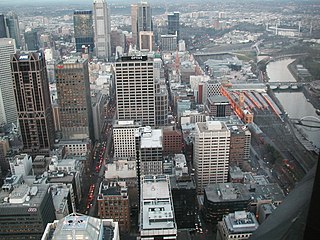
Hoddle Grid is the contemporary name given to the approximately 1-by-0.5-mile grid of streets that form the Melbourne central business district, Australia. Bounded by Flinders Street, Spring Street, La Trobe Street, and Spencer Street, it lies at an angle to the rest of the Melbourne suburban grid, and so is easily recognisable. It is named after the surveyor Robert Hoddle, who marked it out in 1837, establishing the first formal town plan. This grid of streets, laid out when there were only a few hundred settlers, became the nucleus for what is now Melbourne, a city of over five million people.

The Royal Exhibition Building is a World Heritage-listed building in Melbourne, Victoria, Australia, built in 1879–1880 as part of the international exhibition movement, which presented over 50 exhibitions between 1851 and 1915 around the globe. The building sits on approximately 26 hectares, is 150 metres (490 ft) long and is surrounded by four city streets. It is at 9 Nicholson Street in the Carlton Gardens, flanked by Victoria, Carlton and Rathdowne Streets, at the north-eastern edge of the central business district. It was built to host the Melbourne International Exhibition in 1880–81, and then hosted the even larger Centennial International Exhibition in 1888, and the formal opening of the first Parliament of Australia in 1901. The building is representative of the money and pride Victoria had in the 1870s. Throughout the 20th century smaller sections and wings of the building were subject to demolition and fire; however, the main building, known as the Great Hall, survived.
Kamathipura is a neighbourhood in Mumbai, India known for prostitution. It was first settled after 1795 with the construction of causeways that connected the erstwhile seven islands of Mumbai. Initially known as Lal Bazaar, it got its name from the Kamathis (workers) of other areas of the country, who were labourers on construction sites. Due to tough police crackdowns, in the late 1990s with the rise of AIDS and government's redevelopment policy that helped sex workers to move out of the profession and subsequently out of Kamathipura, the number of sex workers in the area has dwindled. In 1992, Brihanmumbai Municipal Corporation (BMC) recorded there were 45,000 sex workers here which was reduced to 1,600 in 2009 and 500 in 2018. Many sex workers have migrated to other areas in Maharashtra with real estate developers taking over the high-priced real estate. In 2018 the Maharashtra government sought tenders to demolish and redevelop the area.

Spring Street is a major street in the central business district of Melbourne, Australia. It runs roughly north-south and is the easternmost street in the original 1837 Hoddle Grid.

Baltimore's The Block is a stretch on the 400 block of East Baltimore Street in Baltimore, Maryland, containing several strip clubs, sex shops, and other adult entertainment merchants. During the 19th century, Baltimore was filled with brothels, and in the first half of the 20th century, it was famous for its burlesque houses. It was a noted starting point and stop-over for many noted burlesque dancers, including the likes of Blaze Starr.

The Levee District was the red-light district of Chicago from the 1880s until 1912, when police raids shut it down. The district, like many frontier town red-light districts, got its name from its proximity to wharves in the city. The Levee district encompassed four blocks in Chicago's South Loop area, between 18th and 22nd streets. It was home to many brothels, saloons, dance halls, and the famed Everleigh Club. Prostitution boomed in the Levee District, and it was not until the Chicago Vice Commission submitted a report on the city's vice districts that it was shut down.

Rue d'Aerschot (French) or Aarschotstraat (Dutch) is a street in the Schaerbeek municipality of Brussels, Belgium. It is known as a hotspot of the city's underground nightlife and famous for its brothels. The street is also known for its inexpensive lodging.
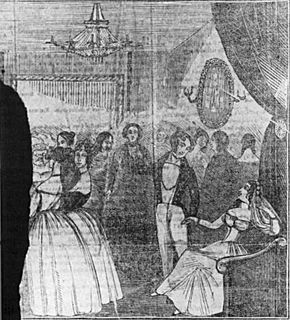
Julia Brown was an American madam and prostitute active in mid-nineteenth century New York City. Brown has been described as "the best-known prostitute in antebellum America". Brown was known for playing the piano in her brothel and for being a guest at functions hosted by the best families in New York. She also had season ticket to two theaters, paid for pews in various churches and contributed generously to local bible societies. She became a popular subject of tourist guidebooks, and her name appears often in diaries from the period.

Lonsdale Street is a main street and thoroughfare in the city centre of Melbourne, Australia. It runs roughly east–west and was laid out in 1837 as one of Melbourne's original boundaries within the Hoddle Grid. The street extends from Spring Street in the east to Spencer Street in the west.
Prostitution in Ireland is legal. However, since March 2017, it has been an offence to buy sex. Third party involvement is also illegal. Since the law that criminalises clients came into being, with the purpose of reducing the demand for prostitution, the number of prosecutions for the purchase of sex increased from 10 to 92 between 2018 and 2020. In a report from UCD's Sexual Exploitation Research Programme the development is called ”a promising start in interrupting the demand for prostitution.”
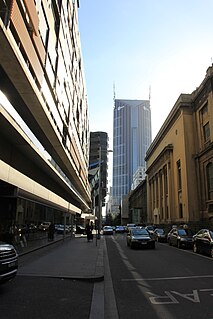
Little Lonsdale Street is located in the centre of Melbourne, Victoria, Australia. A part of the Hoddle Grid, it runs roughly east–west. North of Lonsdale Street and south of La Trobe Street, Little Lonsdale Street's eastern end intersects with Spring Street while its western end intersects with Spencer Street. It was named after William Lonsdale, the first administrator and magistrate in Melbourne. Unlike the other little streets, it runs one-way in the easterly direction, not the west.

Whelan the Wrecker was a family owned and operated demolition company that operated from 1892 until 1992, based in Brunswick in the city of Melbourne. The company became well known through the 1950s and 1970s when signs stating that "Whelan the Wrecker is Here" appeared on many of the grand Victorian era buildings of Melbourne.
Caroline Hodgson, also known as Madame Brussels, was a well-known brothel proprietor and local identity of the Little Lon district in Melbourne, Victoria, Australia, during the late 19th century.

Dorset Street was a street in Spitalfields, East London, once situated at the heart of the area's rookery. By repute it was "the worst street in London", and it was the scene of the brutal murder of Mary Jane Kelly by Jack the Ripper on 9 November 1888. The murder was committed at Kelly's lodgings which were situated at No. 13, Miller's Court, entered from a passageway between 26 and 27, Dorset Street.

The Melbourne central business district in Australia is home to numerous lanes and arcades. Often called "laneways", these narrow streets and pedestrian paths date mostly from the Victorian era, and are a popular cultural attraction for their cafes, bars and street art.
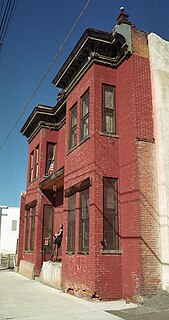
The Dumas Brothel was a bordello in Butte, Montana. The brothel was founded by French Canadian brothers Joseph and Arthur Nadeau in 1890 and named after the nominal owner, Delia Nadeau, née Dumas, who was Joseph's wife. It grew considerably through the years, with the miners employed by the city's copper mines often patronizing the establishment. After several changes of the "madams" and continuing pressure from authorities, the brothel closed in 1982, described as "a rare, intact commentary on social history". At the time of its closure, it was the longest operating brothel in the United States, having operated years after prostitution was made illegal. After closing, the brothel changed hands several times, eventually becoming a tourist attraction owned and managed by a series of Butte residents.
Willie Vincent Piazza was a prostitute and brothel proprietor in the Storyville during that red light district's period of legal operation. From 1898 until the district's closure in 1917, Piazza worked as a madam and specialized in providing octoroon women for her clients; she herself was mixed-race.

Laura Bell McDaniel was an American madam and brothel owner in Colorado City, now called Old Colorado City, and Cripple Creek during the late 19th century and early 20th century. She was also known the "Courtesan of Colorado City" and "Queen of the Colorado City Tenderloin". She had entered the profession after being left with an infant daughter. McDaniel maintained a close relationship with her mother and family over her career and she sent her daughter to boarding school. Her clients were among the wealthy citizens of the Colorado Springs area and she was said to have the "most spectacular [house] in town", managed by a number of servants. Although she was encouraged to leave town by citizens and law enforcement, she continued to operate her business until her death.
Sarah Fraser, also called Mother Fraser was an Australian brothel keeper.
